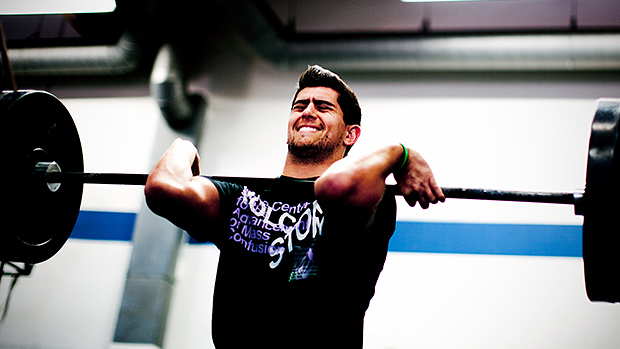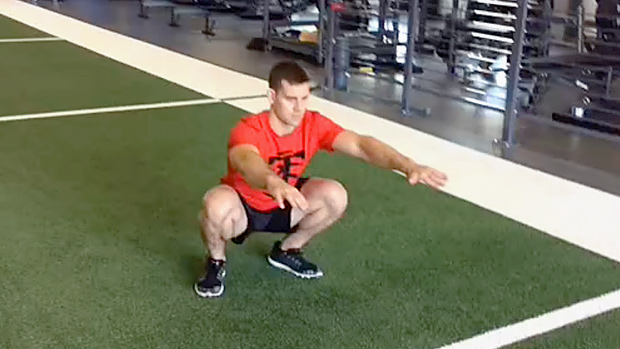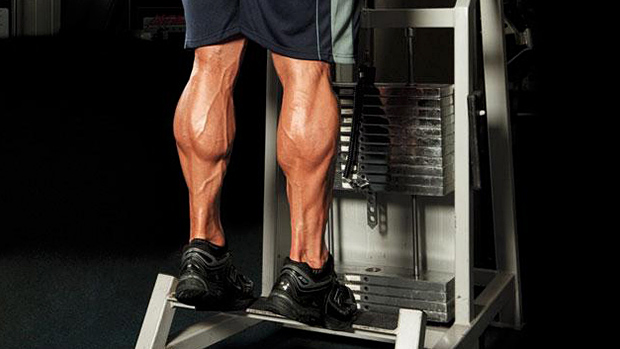"There's no such thing as a hardgainer."
This statement has been the catalyst for heated arguments in the world
of strength-training for many years. The mere mention of the word "hardgainer" on
internet forums will receive more caustic replies than almost any other
term I can think of, with many respondents insisting that the hardgainer
simply doesn't exist, and that a so-called hardgainer is nothing more
than a wuss who lacks the heart or dedication to be successful in the
strength training world.
After all, the number-one motivating factor for the great majority of
us when picking up a weight is to become bigger and stronger, so that
we can attract the eye of Sara Jo Finebottom, that voluptuous little
minx who sits across from us in biology class, right?
Of course, having a common goal is about the only thing trainees have
in common from that point on. Some trainees are more successful than
others: they get to take Sara Jo off to the deserted biology lab after
class, and everyone else has to watch with envy and frustration while
the mesomorphic bastard is in there giving Sara Jo multiple orgasms.
It's the way of the world. So what gives?
The first problem is that the term "hardgainer" is so grossly overused
it has desensitized people into believing that some people, despite hard
training, adequate nutrition, and quality sleep, still find it unbelievably
challenging and even nearly impossible to gain size and strength.
The second problem with the term is its overuse by people who have no
business using it in the first place. Trainees who don't gain 20 or 30
pounds of muscle in 6 months, or who can't seem to gain weight on two
meals a day, often label themselves as
"hardgainers," saying that they just can't gain a pound, or that they've
been stuck lifting the same weights for years. These people are a huge
part of the problem, and why legitimate hardgainers get a bad rap.
I can confidently say that 75% of the people who call themselves
"hardgainers" are simply following absurd nutritional and training programs,
meaning they aren't eating nearly enough, and are either overtraining,
or not training enough!
The people in the group above are also described as being
"ectomorphs," which is a nicely wrapped and easily referenced category.
Ectomorphs typically have a higher metabolism, carry less muscle mass,
and tend to look skinnier and weaker than the other somatypes.
 |
A classic ectomorph.
Terms like "ectomorph," "mesomorph," and "endomorph" may be convenient
for grouping people into categories for easy reference, but they tend
to overlook a lot of individual differences. The following are just a
few of the genetic factors that separate us. These factors are helpful
in explaining why we have differing levels of success in the gym, and
why we can't all be grouped neatly into one of the three basic somatypes.
Cortisol output
Insulin sensitivity
Thyroid output
Thyroid sensitivity
Testosterone production
Growth hormone output
IGF output
Muscle fiber composition
CNS recovery rate
Digestive capacity
Amount of muscle fibers
Length of muscle bellies/tendons
Muscle insertion points
These are only a few of the factors that separate the responders from
the non-responders. The upshot is that we don't all respond to
the same stimuli in the same way, and that genetics matters. A lot.
In fact, the ultimate factor in determining your success in the gym
is your genetic capability to do so. No supplement or training program
is going to increase the number of muscle fibers you were born with,
change your muscular insertion points, or change the length of your muscle
bellies. This isn't a rationalization, it's the harsh truth.
Because the typical Testosterone reader is smarter than the average
bear, I won't waste any more space talking about my various gripes about
somatype classifications. Let's stick to the good stuff, and get right
to the point.
 |
Typical T-Nation reader.
So: time for a pop quiz. I'm going to ask you one question, and I want
you to consider your answer carefully. Here it is:
Are all hardgainers created equal?
In other words, if you're a hardgainer, do you have the same set
of problems as other hardgainers, and should you expect the same set
of solutions to solve them?
Take your time.
Ready?
The answer you should've come up with, if you read the title of this
article and have been paying attention up until now, is:
"No, of course not!"
Remember the list of genetic factors: every true hardgainer is different.
However, just to keep things simple, I'll divide the true hardgainers
into two groups: the easy-hardgainer and the skinny-fat hardgainer.
Members of each group have problems they have to tackle before they can
achieve success, including poor digestive capacity and high thyroid output.
The difference between the two is that the second group's problems are
more serious than those of the first group.
The problems of easy-hardgainer are, as the name implies, relatively
easy to fix. All these guys have to do is increase their ability or willingness
to take in the correct amount of food, and perform the correct exercises
in the gym to stimulate good anabolic hormonal signaling (Testosterone).
When they finally knuckle down with the fork and knife they often find
their "genetics" improving by the plateful, so to speak. Many athletes
such as sprinters, track and field stars, and even a famous professional
bodybuilder who shall remain anonymous (hint: his last name rhymes with "farts
a beggar") fall within this group.
 |
Easy-hardgainers like this guy can solve most of their problems by
training harder and eating more.
The skinny-fat hardgainer is much worse off than the group above. This
is the group I will focus on for the remainder of this article. The problems
of the skinny-fat hardgainer are twofold, and they should be self-evident
by looking at the name.
Skinny = catabolic
Fat = insulin resistant
This group is constantly in a catabolic state, which in itself causes
one to be insulin resistant. If a skinny-fat hardgainer tries to apply
the same approach that works for the easy-hardgainer (eat more food),
he just ends up as a Richard Simmons lookalike: slim, but with very little
muscle and too much fat.
 |
Skinny-fat hardgainers have serious issues.
Although the skinny-fat hardgainers have some of the same problems as
their easy-hardgaining friends, three other, more serious problems set
this group apart: poor hormonal signaling, poor digestive capacity, and
a low work capacity.
Poor Hormonal Signaling
The skinny-fats have hormonal signaling problems, meaning they're deficient
in the anabolic hormones, the ones you need to build muscle. Compared
to strength trainees with Testosterone levels of 700 or over, someone
whose T-levels are at only 300 or so isn't going to carry nearly as much
muscle mass naturally, or respond to training the same.
A skinny-fat hardgainer has to contend with a one-two punch: a shortage
of Testosterone and other androgens, coupled with an overabundance of
cortisol and other catabolic hormones. Cortisol is often referred to
as the "stress hormone," and it's essential for life in many ways, but
for hardgainers, it's is a huge pain in the ass. Cortisol inhibits protein
synthesis and breaks down proteins, literally eating up the muscle tissue
that they work so hard for in the gym and at the dinner table.
Cortisol also negatively influences insulin sensitivity, because its
job is to break down (mobilize) energy stores such as skeletal muscle
to keep a constant supply of glucose in the bloodstream for energy use
by peripheral tissues and the brain. Remember, insulin sensitivity is
very important in our nutrient uptake, and what our muscle cells or fat
cells take in. The more insulin sensitive you are, the more muscular
and leaner you'll be.
The take-home point here is that you need to switch your body from being
in a constant catabolic state, and allow it to run on your anabolic hormones
like it naturally wants to. This will increase insulin sensitivity and
Testosterone production so you'll be bigger, stronger, and leaner!
Poor Digestive Capacity
All of us at one point or another in our lifting careers have been subject
to having digestive issues such as bloating, gas, and stomach cramps.
For most people this is a once in a while occurrence, and is taken in
stride as a price of playing the iron game.
However, imagine for a second that this is a daily occurrence for you,
and you'll begin to relate to a true hardgainer and their digestive problems.
It seems like a cruel joke that a hardgainer's elevated metabolic rate
requires him to eat more calories than the usual trainee in order to
put on quality muscle, but he has to deal with the fact that he can only
stomach two or at most three meals a day!
I know all about digestive problems, having suffered more than my share.
I know what it's like to have that hearty bodybuilding breakfast sitting
in your stomach all day like a ball of lead. This leads hardgainers down
the road of liquid nutrition with whey proteins, which in turn opens
up a whole new set of problems in digestion, nutrient absorption, and
insulin sensitivity.
A major factor in how well you digest and ultimately absorb what you
eat is hydrochloric acid (HCl). If you're deficient in this area, proteins,
carbohydrates, and fats won't be properly absorbed.
The take-home point here is that hardgainers are practically starved
for quality nutrients due to poor digestive capacity, and as a result,
poor absorption of vital nutrients that repair and rebuild tissue after
strenuous exercise.
Low Work Capacity
The third major obstacle that our skinny-fat hardgainers must overcome
deals with their poor ability to recover between strength training sessions.
If you're a hardgainer and are reading this, you've no doubt tried
the routines that are marketed as the only suitable routines for
hardgainers.
These routines are typically super-abbreviated, very low volume, and
low frequency routines in which adding weight in small amounts at every
session as the only form of progression. These routines usually call
for one or at most two sets at maximum intensity with many days of recovery
in-between.
Hardgainers have found short-lived success with these routines, because
the reduced volume and frequency allowed their nervous system and muscles
to recover fully from the previous training. When the smoke clears, however,
every aspect of fitness such as muscular endurance, strength, power,
and muscle mass are severely diminished or totally gone. The low volume
and low frequency also lowers the trainee's metabolic rate, this only
leads to more fat gain.
The take-home point here is that you'll make the fastest gains in muscle
and strength with the most frequent training sessions you can recover
from. The only way you can increase your rate of recovery is by challenging
your body to recover faster than it's used to. If you stay with these
low volume routines, you'll be in a prison with no way out, and will
never realize your ultimate potential. Hardgainers must build up their
capacity to handle more frequent training sessions with more volume,
which is the exact opposite of what most are doing right now.
The Key Piece of the Puzzle: the Nervous System
The human body is a magnificent organism that is highly adaptable to
any situation. If it weren't, we obviously wouldn't be here. Our body
has an optimal set of parameters that it likes to keep all our physiologic
processes constant, such as temperature regulation, blood pressure, oxygen
content, acidity, etc. This is referred to as homeostasis, the body's
ability to maintain a relatively constant internal environment. Anything
from the outside world that knocks your body out of homeostatic balance
is referred to as a stressor. When confronted by a stressor, your
body responds with a stress response in order to re-establish the balance.
This intricate and highly adaptive response is known as the
"fight or flight" response, and is mediated by one branch of your autonomic
nervous system, the sympathetic nervous system. This is the physiological
system that kicked in when we had to escape predators back in the Paleolithic
Age, and now takes over whenever we have to deal with the assault of
oncoming traffic, belligerent drunks, and angry girlfriends.
 |
At least as stress-inducing as a Paleolithic predator.
The system kicks in during emergencies, or more precisely, what we
perceive to be emergencies. When this response is activated, your
heart rate increases, blood pressure and breathing increase, and the
muscles are flooded with blood and nutrients in preparation for swift
activation to get your keister out of harm's way.
The stress response is characterized by rapid mobilization of energy;
this comes from your liver, your fat cells, and (unfortunately) your
muscles. This system is the result of our body releasing certain hormones
that mediate these responses, namely the catecholamines (epinephrine
and norepinephrine) and the glucocorticoids (cortisol being the most
important).
The catecholamines are activated by way of sympathetic projections that
exit the spine and branch out to organs and blood vessels in the body,
acting within seconds. The glucocorticoids are released by the adrenal
gland, and back up the activity of the catecholamines over the course
of hours.
The adrenal gland is under direct control of hormones in the brain,
namely corticotropin releasing hormone (CRH) and adrenocorticotropic
hormone (ACTH). When the ACTH is released into the bloodstream it then
reaches the adrenal gland and triggers the release of glucocorticoids.
Try saying all thatten times fast.
 |
Your adrenal glands trigger not only the fight-or-flight response,
but also the fat-and-flat response.
If you're still with me after those last two paragraphs, you should
realize that these are all catabolic processes, and the stress response
puts a halt to all long term projects (like building muscle and strength)
by decreasing Testosterone production, inhibiting digestion and food
storage, and constantly breaking down tissue for energy use.
The other branch of the autonomic nervous system is called the parasympathetic
nervous system, and it opposes the sympathetic nervous system. This system
is the exact opposite and promotes growth and energy storage by way of
our friendly anabolic hormones.
These two systems can't run simultaneously, thus if your sympathetic
nervous system is running full bore, the parasympathetic tone is turned
way down. This is where our hardgainers get into trouble. With the exception
of places like the Okavango Delta, human beings are no longer a link
in the middle of somebody else's food chain, and don't have to worry
too much about becoming lunch meat.
 |
Most of us don't have to worry about being on the menu anymore.
Instead, we have invented a whole new set of stressors to worry about.
Jobs, relationships, finances, and jostling for a seat on the morning
commuter train all take their toll on our health by way of added stress.
The problem is that the human body perceives these relatively minor events
as life-threatening stressors, and responds to them just as it did when
our ancestors were running from sabertooth lions, tigers, and bears.
Oh, my!
The biggest irony is that our bodies will react to stress without the
stressor even being real. We have the dubious honor of being the
only species able to mobilize a full-blown fight-or-flight stress response
simply by worrying about whether that zit on our foreheads just might
be the beginning of terminal cancer!
This is one instance where the stress response actually does more damage
to our body than the stressor itself. Recognizing this fact is paramount
in understanding the issues a skinny-fat hardgainer has to overcome.
The Primary Culprit Revealed
Poor hormonal signaling, poor digestive capacity, and a low work capacity
are the major problems facing our skinny-fat hardgaining friends, and
these problems are the root cause of the one limiting factor that
all people in this category share: the one they must come to grips with
if they ever want to break free, and achieve the results they desire:
Skinny-fat hardgainers suffer from an overactive sympathetic nervous
system, and an extreme hypersensitivity to stress of any kind.
You should see the connections. The poor hormonal signaling is the result
of the body constantly dealing with and overacting to random stressors
that normal people handle without notice; the catabolic hormones are
running rampant as these people can't cope efficiently with daily stressors
of any kind.
The low work capacity is a direct result of the body being under so
much stress at a constant level, the central nervous system is overloaded
very easily, and overtraining occurs very rapidly. Forget about recovering
from heavy resistance training: these guys can barely recover from life.
Digestive issues and insulin sensitivity problems are directly linked
to the fact they are constantly mobilizing energy for use, their body
never gets a chance to properly store its nutrients because the SNS is
so overactive in these guys it puts all the long term projects like digestion
and storing glucose properly for tissue repair on the back burner for
immediate survival. Stress is also the culprit in producing lower levels
of HCl, which is essential for digestion and absorption of nutrients.
If you've ever worked with guys like these, all of this should be making
perfect sense. You know the type: the trainees with the
"worry-wart" mentality, who constantly nitpick, overanalyze, and stress
about not gaining muscle. They even stress out about stress!
 |
People who stress out all the time usually end up looking like this.
The Corrections
Step 1
There is hope yet for our hardgainer friends. The first thing they must
do is learn to effectively cope with daily stressors. This will eliminate
many of the digestive issues, solve the CNS issues, and revert their
body back to more favorable hormonal signaling.
This is best done by finding some sort of coping mechanism or outlet
for our daily stressors. My preferred method is a daily walking meditation:
just walk for an extended period of time, all the while being extremely
mindful of your surroundings, young Padawan.
A good supplemental exercise is belly breathing. Try to pull as much
air into your stomach as you can then let it out, making sure your stomach
is what is expanding, and not your chest!
Any kind of relaxation or stress reduction technique is fine, so find
what works best for you. The important thing is to identify the events
and people in your life that are causing you stress, and eliminatethem
(within the limits of the law, anyway). If you can't totally remove the
stressors in your life, then at least find an effective way to cope with
them. You need to deal with this before anything else, otherwise your
goals will always elude you.
Step 2
You must take in enough antioxidants to help offset all the damage you
are putting your body through. A diet full of veggies and fruits is paramount.
You must also eliminate all whey-only protein shakes from your diet.
Whey is absorbed very rapidly (and therefore poorly), and contains amino
acids that are quickly converted to glucose upon ingestion. This spikes
your blood sugar, which is not what you want if you're trying
to get over insulin sensitivity.
Supplements
If you're a regular reader of T-Nation, then you know that Biotest has
lots of awesome supplements, but I recommend three in particular, to
assist you in your quest to break free from the hardgainer slump.
Superfood is an essential source of antioxidants. Take one serving twice a day.
Flameout is great for improving insulin sensitivity and body composition.
Metabolic
Drive is the only protein powder you should be putting into your stomach: the
blend of whey isolate and micellar casein won't wreak havoc on blood
glucose levels the way pure whey can, and it'll be absorbed in a slow
and controlled fashion.
It's a Lifestyle
I understand what all of you true hardgainers are going through, because
I've been there. Every issue mentioned in this article is one I've dealt
with and overcome, and I know you can do it as well. I'm not just another
author writing about a topic I observed from a distance. I'm part of
the hardgainer population, and I learn more and more everyday how we
can overcome our seemingly insurmountable set of obstacles. I've made
great strides toward my goals, and I know you can too.
Now get to it!
References
Sapolsky, R. M. (2004). Why Zebras Don't Get Ulcers. New York,
NY: Henry Holt and Co.
Waterbury, C. (2006). Muscle Revolution. Tucson, AZ: City Press.
Silverthorn, D. U. (2007). Human Physiology. San Francisco, CA:
Benjamin Cummings.
Poliquin, C. (2007). Question
of Strength.
Testosterone nation. Retrieved Feb. 22, 2008





